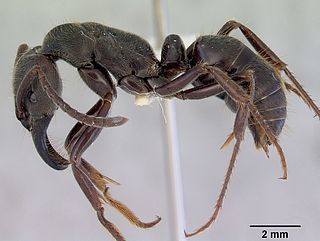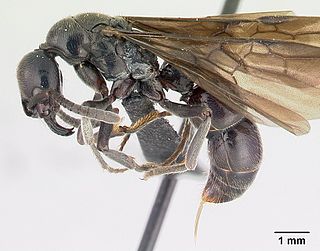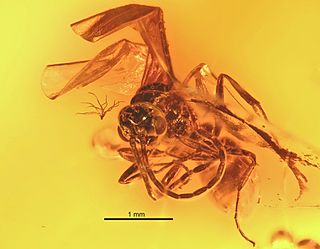
Ponerinae, the ponerine ants, is a subfamily of ants in the Poneromorph subfamilies group, with about 1,600 species in 47 extant genera, including Dinoponera gigantea - one of the world's largest species of ant. Mated workers have replaced the queen as the functional egg-layers in several species of ponerine ants. In such queenless species, the reproductive status of workers can only be determined through ovarian dissections.

Ponera is a genus of ponerine ants. The name is the Latinized form of the Ancient Greek ponira.

Cryptopone is a genus of ants in the subfamily Ponerinae. The genus has a worldwide distribution, with most species occurring in Asia. Workers range from very small to medium in size (1.7–6.1 mm), with the queens being slightly larger.

Simopelta is a Neotropical genus of ants in the subfamily Ponerinae.

Thaumatomyrmex is a Neotropical genus of ants in the subfamily Ponerinae, found from Mexico to Brazil. They are notable for their pitchfork-shaped mandibles, which they use to capture millipedes of the order Polyxenida. The genus is a specialist predator of polyxenids, and one of only two ant genera known to prey upon polyxenids.

Belonopelta is a Neotropical genus of ants in the subfamily Ponerinae. The genus contains two species: B. deletrix is known from Mesoamerica and Colombia, while B. attenuata is only known from Colombia. Members of this genus are rarely collected, and little is known about their habits. Males remain unknown for both species, and queens and larvae have only been described for B. deletrix.

Boloponera is a genus of small ants in the subfamily Ponerinae. The genus contains the single species Boloponera vicans, known from a single worker specimen collected in leaf litter in the Central African Republic. It is sometimes referred to as Bry's ant after its discoverer, Brian Fisher.

Buniapone is a monotypic genus of ants in the subfamily Ponerinae. Buniapone amblyops, the single described species, is found in Southern and Southeast Asia.

Iroponera is a monotypic genus of ants in the subfamily Ponerinae. Iroponera odax, the single described species, is known only from a few collections in Australia.

Brachyponera is a genus of ants in the subfamily Ponerinae.

Parvaponera is a genus of ants in the subfamily Ponerinae. The genus is distributed in Africa, Southeast Asia, Australia and the Solomon Islands. Workers are slender and small in size. Queens are similar to workers, but larger and winged.

Rasopone is genus of ants in the subfamily Ponerinae. The genus is restricted to Central and South America.

Paltothyreus is a monotypic genus of ants in the subfamily Ponerinae. Paltothyreus tarsatus, the single described species, is widely distributed in Sub-Saharan Africa. Workers are very large in size (17–20 mm); queens are similar to workers, but larger (23 mm) and winged.

Ectomomyrmex is a ponerine genus of ants found in Asia and Australia. Little is known about their biology, but they seem to be generalist predators of arthropod prey.

Euponera is a ponerine genus of ants distributed in the Afrotropics and eastern Asia. Workers are large (6–10.5 mm); queen are similar to workers, but larger and winged.

Hagensia is a small genus of ants in the subfamily Ponerinae. Its two species are known only from coastal areas in South Africa. Workers are large (10.5–13.0 mm); queens are unknown, but gamergates occurs in both species.

Mayaponera is a genus of ants in the subfamily Ponerinae. It contains the single species Mayaponera constricta, found in Central and South America. Workers are slender and medium in size (6–7.5 mm).

Neoponera is a genus of ants in the subfamily Ponerinae. Restricted to the Neotropics, the genus is found from southern Texas to southern Brazil. Workers are slender, and medium to large in size (6.5–19 mm); queens are similar to workers but larger and winged.

Pseudoneoponera is a ponerine genus of ants found from India to Australia, they are mostly non queen species, most of the species within the genus thrives on only gamergates.

Pachycondyla succinea is an extinct species of ant in the formicid subfamily Ponerinae described from fossils found in Europe. P. petrosa is one of three middle Eocene Pachycondyla species found in Baltic amber.




















